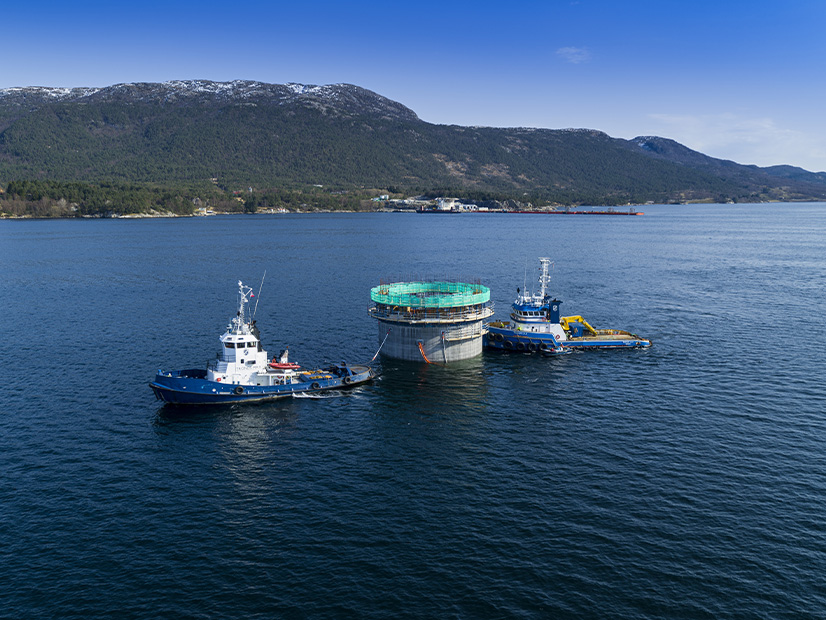
Maine officials are looking at beginning a phased offshore wind procurement process following an anticipated 2024 Gulf of Maine federal lease sale, Celina Cunningham, deputy director of the Governor’s Energy Office, said Monday.
“What we are seeing from the energy needs for the region and the state is that, over the long term, OSW will be an important part of our energy mix to meet our clean energy and emission-reduction requirements,” Cunningham said during a Maine Offshore Wind Roadmap Advisory Committee meeting.
Cunningham presented the Energy Markets and Strategies Working Group’s initial roadmap recommendations to the full committee, saying an OSW target should accompany the procurement.
The U.S. Bureau of Ocean Energy Management (BOEM) announced plans in October for seven potential new OSW lease sales by 2025, including one in the Gulf of Maine. BOEM said it could designate a gulf wind area by mid-2023 and hold a lease sale in the third quarter of 2024.
The working group expects to finalize an energy needs analysis before identifying what it believes Maine’s OSW target should be, according to Cunningham, who added that pursuing a cost-effective energy strategy for the state is a priority.
Based on water depths, OSW development in federal waters of the gulf will require floating wind turbine technologies. The current floating wind market, however, is small, totaling 79 MW of installed capacity, according to the U.S. Department of Energy’s 2021 Offshore Wind Market Report.
By 2050, DNV estimates the U.S. will have 279 GW of OSW, and 47 GW of that total would be floating, Principal Consultant Ari Michelson told the committee. DNV has been supporting the working group with analyses on OSW potential for Maine.
Floating OSW development likely will not kick off significantly in the gulf until 2040, and it could more than triple in size by 2050, according to Michelson. DNV is currently finalizing its estimates for floating wind capacity in 2040 and 2050 for the roadmap.
In addition, he said the global levelized cost of energy (LCOE) for floating wind should drop rapidly through 2030, potentially hitting $39/MWh for the gulf in 2050. Globally, the average LCOE of fixed-bottom OSW installations is $95/MWh, according to the DOE report. Mayflower Wind has one of the lowest-priced OSW projects in the world at $71/MWh.
The committee heard initial recommendations from three of its working groups Monday, with additional recommendations still to come from the Fisheries Working Group in January. After taking feedback from stakeholders early next year, the working groups will present refined recommendations to the committee in July. The final roadmap is due in December 2022.
Supply Chain and Workforce
Maine should be connecting with the international OSW market as the state builds out its assets in the coming years, Steve Von Vogt, executive director of the Maine Composites Alliance, told the committee.
“We would like to see advocacy on the part of the state through its policies and economic outreach for Maine’s firms and industry, ports, workforce and excellent R&D related to offshore wind,” Von Vogt said in a presentation for the Supply Chain, Workforce Development, Ports and Marine Transportation Working Group.
The group’s initial recommendations included establishing a “commissioner-level industry advocate.”
The state needs a “consistent and high-level strategic effort to align Maine’s assets across industry, R&D, education and workforce development, to market opportunities,” Von Vogt said.
To accomplish that, the group suggested that the state “formally establish clear state policy supportive of OSW” and “announce an OSW goal or mandate.”
Developing Maine’s OSW workforce may require the state to ensure that students are engaged early in understanding the long-term opportunities for the industry, said Jonathan Poole, large business development manager at the Maine Department of Economic and Community Development.
To do that, Maine can expand STEM education for K-12 and continuing education students, Poole said in a presentation to the committee. The state, he said, also could increase OSW opportunities in post-secondary education by replicating its successful efforts to generate talent in the pulp and paper industry.
In addition to promoting the University of Maine’s long-term work on floating wind technologies, the state also could leverage its existing maritime sector programs, according to Poole.
“Improving the professional certifications in the maritime sector is what is going to be required by a lot of OSW developers and operators coming into the gulf,” he said.
Wildlife
Among the Environment and Wildlife Working Group’s top priorities for the roadmap is a drive to ensure that the state is prepared to communicate its needs to the federal government in the OSW citing process for the gulf.
There is a lack of data for the gulf; the existing data are old; and the gulf’s environment is in flux because of climate change, said Wing Goodale, science director at the Biodiversity Research Institute.
With that in mind, the group’s initial recommendations include using existing data to begin identifying areas of greatest conflict and the data gaps that need filling to inform OSW leasing, Goodale said. With input from science and fishery experts, the maps can be updated over time.
The group also wants to investigate Maine’s authority under the Coastal Zone Management Act (CZMA) to review federal activities that could affect the state’s coastal areas. The CZMA may provide the state with opportunities to address “issues of concern” regarding OSW development in federal waters, and the investigation could lead to potential changes in state laws, Goodale said.


